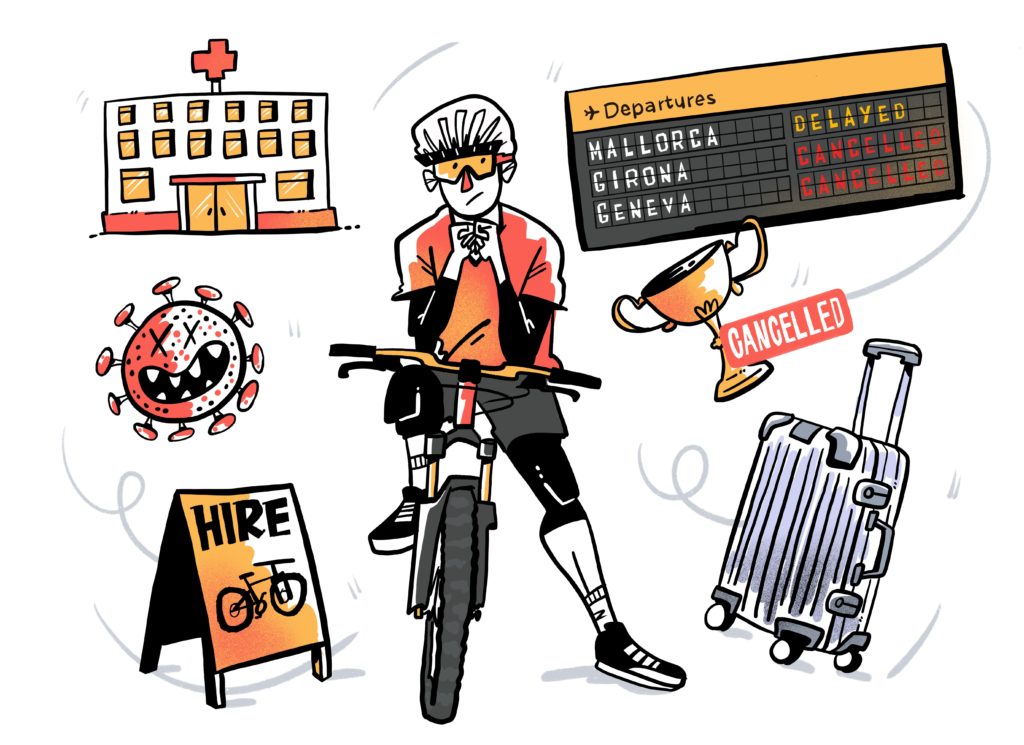If you’ve opened your eyes at any point since February you may have noticed an increase in the cost of energy. It’s becoming rather expensive to turn on the plugs and this has led to speculation that more of us will be unplugging our smart trainers this winter and heading outside! This inspired Pedalcover to ask me to work out what’s actually cheaper – can we run the numbers and figure out which is cheaper this winter, riding indoors or outside? And by how much?
Our model scenario
In order to ascribe costs to various actions, we will have to come up with some kind of model scenario. We need a rider doing a reasonable amount of training – let’s say 8 hours a week. Their typical training week might look like this…
Monday – REST DAY
Tuesday – One hour interval session
Wednesday – Two hour endurance ride
Thursday – REST DAY
Friday – One hour endurance ride
Saturday – One hour recovery ride with the family
Sunday – Three hour club run
For this to be kept simple, we will assume our rider is a 75kg male who is averaging 200W on every single ride. Obviously, all the costs work out differently if you change these numbers but this is for illustrative purposes only.
The power from our rider is useful, as we can see how much energy is expended. Power is a measure of energy used per unit of time, so if our rider is doing 200W for eight hours, we can calculate the amount of energy they are using.
We calculate the amount of energy, in kJ, by multiplying the number of watts by the number of hours by 3.6.
So, 200W per hour is 720kJ per hour, multiply that by 8 (hours of riding) and we have a rider producing 5760kJ per week with his legs.
Humans are around about (very roughly) 25% efficient. This means, to produce 5760kJ at the pedals, we use about four times that energy. The upshot of all of this, is that our rider is burning an extra 5500kcal per week from cycling. Happy days.
Cost of human fuel
Let’s imagine our rider fuels all their rides by consuming 50g of carbohydrates per hour of easy riding and 100g per hour of hard riding. That means we have a rider eating 450g/week of carbohydrate on the bike.
Bananas are easy to eat on the turbo and outside and 450g of carbohydrate is around 20 bananas. From Tesco (other supermarkets are available and potentially cheaper) a single loose banana costs 14p according to their website. Our rider is fuelling with an extra £2.80 per week – sort of… With 20 bananas we have an energy deficit so our rider will be losing weight. Assuming this isn’t something we are trying to do we need to fill the 3400kcal gap with extra food. This is an extra 5 meals per week – doing some rough and ready maths this works out around an extra £13 per week. So our bike riding is costing us, already and only with food, £15.80 per week!
The cost of riding outside
Learning this and thinking about the cost of plugging in your smart trainer on top, it can be tempting to cancel your membership straight up – but it’s worth noting that riding outside isn’t actually ‘free’ either. With the grubby road conditions leading to faster wearing components and cold weather requiring more laundry – it seems we have some maths to do.
To ride on the turbo, our imaginary man doesn’t really need anything other than shorts and socks (as he isn’t into triathlon nor is he worried about going shirtless). This isn’t much compared to bib-tights, baselayer, socks, a jersey and a coat needed to ride outside – which generates roughly five times as much laundry – so instead of one load per week dedicated to kit, he will be doing perhaps three loads. At around 50p per wash – all in – this means we are spending £1.50 per week on washing alone, never mind purchasing all the layers needed to satisfy the British climate.
In terms of components, it’s hard to quantify the exact increase in deterioration a dirty chain can cause. Let’s just assume it makes it wear twice as fast, so we would need two new chains over winter instead of one. This is £60 on chains per winter, over our 13 week winter period that’s a cost of £4.60 per week.
In total, our winter riding outside is our food cost of £15.80, plus £4.60 for components plus £1.50 on washing. That’s a total of £22.90 per week on cycling… What happens if we head inside?

The cost of Zwift
We already know our laundry cost from earlier – that’s sitting pretty at 50p per week. Cycling indoors is hard work, as you’ll know if you’ve done it. Getting hot can reduce human efficiency quite considerably. This means we might go from 25% to 20% efficiency (it may not actually be this much, it may be more, but 5% is nice for illustrative purposes). As a result, our food costs will now sit at £18.96 per week.
On top of this, we have electricity. From Facebook we have found the following which inspired this article…
“I saw a post recently suggesting that Zwifters might Zwift less this winter season due to the high cost of electricity so I plugged in my TAPO smart plug into the socket that runs all my kit. (PC & 24″ monitor, 2 fans, bluetooth speaker and Tacx smart trainer. I rode hard for an hour after which I checked the power usage and even being pessimistic I would say my session used less than 500W. If electricity costs 50p per kWh that’s only 25P for the hour session.”
So, 25p per hour of electricity gives us an extra £2.00 per week. Now we can add this up to see what we get. £2.30 per week from components, £18.96 from food, £0.50 from laundry and £2.00 from electricity. Adding in our Zwift subscription at £3.25 per week we have £27.01. Zwift is, in this scenario, £4.11 per week more expensive!
This will cost you £53.43 over the course of a 13 week long winter. I’ll leave it up to you to decide if getting wet is worth it or not…
Don’t forget, if you do decide to splash out on a new smart turbo set up, Our Pedalcover home and bike insurance can cover up to £10,000 worth of equipment in your garage without having to list the items.










